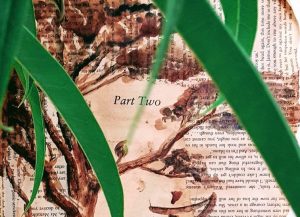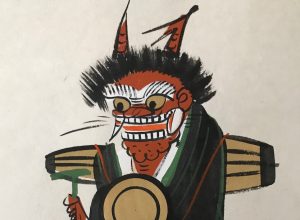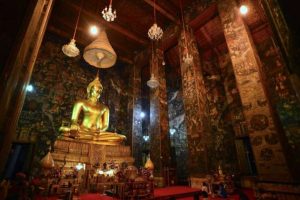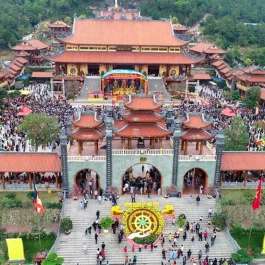Every human being’s path in life is unique. The myriad events, challenges, and relationships we encounter are refracted and scattered across time and memory. We require the exercise of imagination, creativity, and artistic interpretation to make sense of our personal journey. This preoccupation has been the lifelong fascination of Françoise Issaly. A Shanghai resident and French-born artist, she is a Buddhist practitioner whose Dharma learning has helped to inform her painting. Issaly believes that abstract art brings a unique twist to traditional Buddhist ideas. By creating abstract forms, which offer the space for subjective interpretation, she helps viewers question the nature of reality and what is presented before one’s “sight.”
“In many of the works I’ve done before, even though I was not directly using elements of Buddhist or Chinese iconography, the concepts behind the series were often related to spirituality,” she says during our interview in Shanghai. Issaly is the artist-in-residence at The Swatch Art Peace Hotel, on the famous Bund that has defined the megalopolis’s urban history and architectural and artistic heritage since the 1860s: “I question the notion of perception, the balance between extremes, or more particularly, the idea of the in-between things. My work is often about maya, or illusion: what we think we know but do not, as well as what we think we see, but is actually not there. Through abstract forms that only vaguely hint at figures, my art can appear as one thing to one person and something else to another. My paintings attempt to deconstruct the so-called solidity of the world around us and its definitions.”
Issaly’s work has been displayed at solo and group shows in Canada, China, France, Germany, Malaysia, and the US. Her work can be found in many private collections around the world. Issaly also has a new exhibition, titled “More Than the Eyes Can See,” which is runs until the middle of September at Holarte Galerie in Hangzhou. This is her 12th exhibition since she moved to China in 2018.
Issaly was born in Béziers, a subprefecture in the south of France. From a young age she aspired to be an artist. She graduated from University Paul Valery in the city of Montpellier and University Michel de Montaigne in Bordeaux, where she obtained respectively a DEUG in Plastic Arts and a License and Master in Visual Arts. She tells me that she had always been eager to go to Canada and China. First, she set her sights on Canada. She did three years of research for her doctorate before moving to Montreal in 1993. There, she spent around two decades working as a professional artist and art instructor at the University of Montreal and the Montreal Museum of Fine Arts.
It was in the midst of a personal challenge, while living in North America, that Issaly found Buddhism: “I became a Buddhist, really, when I was 27. Before that, I had already considered myself a Buddhist but had not received any teachings. After my mom died, I became preoccupied by questions of life and death. One of the milestones on my personal journey led me to a Buddhist center established by Kelsang Gyatso in Montreal. There, I went to listen to teachings, and it immediately made sense to me. I had a chance to go to England the following summer and listen to his teachings. I have been an ‘official’ Buddhist since then.
“Buddhism is down-to-earth and very concrete. Gyatso remains my spiritual guide. He came to England in the 1970s to teach, and still lives there. Thanks to his guidance, I consider myself a Mahayana Buddhist.”
It took Issaly some time to think about how to integrate her Buddhist practice into her art. “I see my life as ‘one,’ with no components separate. It is important for me to be in harmony with myself, my art, and my spirituality. It is one single experience. When I first embraced Buddhism, I started wondering about the position of art in my Buddhist practice, and whether it would be in opposition,” she explains. “After I took refuge, I even went through a long period when I decided to deliberately not paint. I wanted to see if art was really a fundamental part of me, and who I was without it. For one year, I stopped painting. I practiced meditation and received teachings during that time. I was also traveling to India, the UK, Spain, and France. At the end of that period, I concluded that art and creativity are an essential part of who I am. Art is my outlet, my platform, for how I practice and express the Dharma. Just as Buddhism teaches no-self, we do not need to be restricted by self-imposed categories. There is no conflict between the two. Therefore, I believe that Buddhism and art are not in opposition to each other. They are one single thing.”
Prom Issaly’s perspective, her life path became richer and fuller once she was able to make sense of the interconnection between Buddhism and art: “Now I use art as a way to better understand the world and my mind. By repeating the process of painting, and by using the same patterns over and over within each series, I am meditating on understanding the world around me and making sense of the chaos.”
Issaly believes that Buddhism has energized her activity of making art: “I think that even though I was painting before I became a committed Buddhist, my Dharma practice allowed me to be more consistent with my artistic work. It helped me to be more focused and go deeper into my research and drawing. It allowed me to continue working even while I was [and still am] filled with doubts and questions. Over the years, I do think that my Buddhist practice fed my art practice by making it more tangible. It also contributed to my concentration and my determination. So ultimately, I think that my art practice became my Buddhist practice. At first, I questioned the importance and even the feasibility of making art as a Buddhist, but I realized that this is how I can follow the teachings best—by doing what I am supposed to be doing and what I do best.”
Issaly also identifies Buddhist insights and wisdom through her everyday life as an artist: “This is what is amazing about Buddhism. It is through our daily life that we can practice the best. With regards to the patterns that I work on, I think I can say that beyond the fact that they are visually interesting to me, they are a way to focus on a particular state of mind. Working with patterns is a meditation in itself.”
Issaly continues to explore new ideas and push boundaries related to Buddhism. Between 2018 and 2021, she created a series of artworks called Cloud Gliding while she was working and living in Hangzhou and Shanghai. The series retains strong Buddhist elements, and subtly hinted to viewers that the artist is familiar with Buddhist thought: “I think my artworks have always had a strong spiritual connection. Of course, my Cloud series has that obvious theme. It started by me using and observing the different patterns that were used in thangka paintings; the elements that were surrounding the Buddha. I was asking myself if the absence of the Buddha still made the Buddha present. In a painting, the positive-negative space is crucial. I have always been interested in the fact that there is more to reality than the eye can see. In Vajrayana Buddhism, we also use this practice in meditation. We are asked to see beyond appearances and look with a deeper sight. In one of my series (Configuration 2000–05), I explored what was ‘between’ things when there was ‘nothing,’ and how the mind re-creates something that is not there, making assumptions and constructing fabrications.”
Issaly uses her visual language to comfortably take the viewer toward this state of the “in-between” in the mind. “I would like my audience to pause, look at my work, and ponder. I wish to bring people to that place of the ‘in between,’ where you recognize something familiar, calm, reassuring . . . and at the same time, you know there is more to it . . . and you cannot put your finger on it, so you stay there, lingering, wondering. Maybe not even consciously, but you are suspended between here, now and then, between knowledge and ignorance. I would like people to be in that place, between extremes: like on a kind of razor blade, but without the stress, of course!” she concludes.
Her discovery of Buddhism caps a long personal journey of discovering her artistic talents, becoming her own creative person, and going to live and work in Canada and China. In this way, Issaly’s art practice and spiritual development have been combined to help her find direction and purpose in life.
See more
Related features from BDG
Oceans’ Rise – Swirling Messages from Dream and Imaginal Realms
Anam Cara: The Quiet Miracle
The Mandala of the Five Dancing Wisdoms within Our Hearts


















